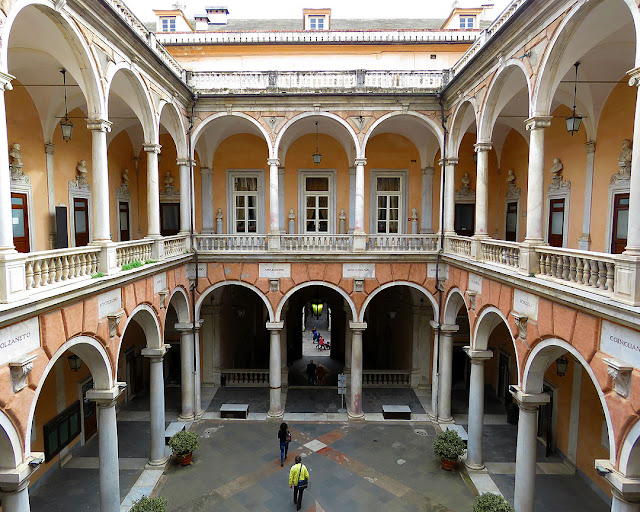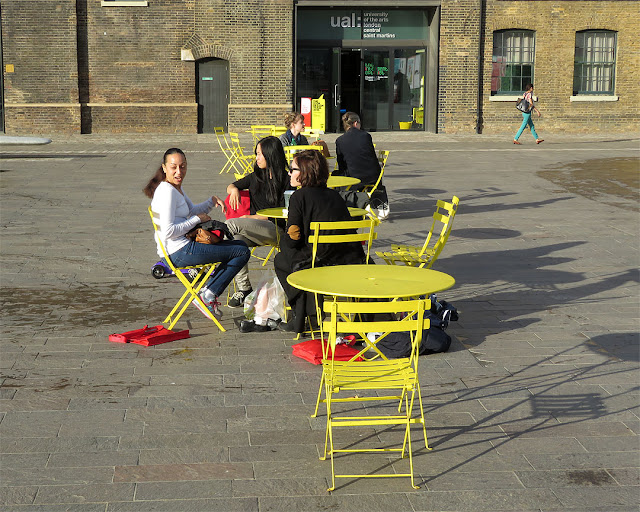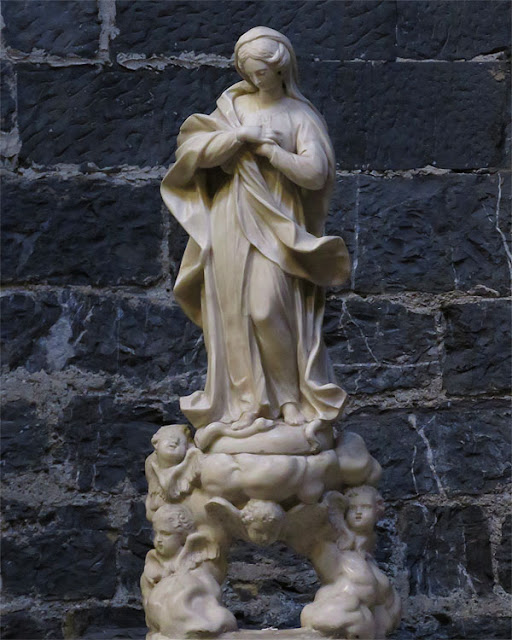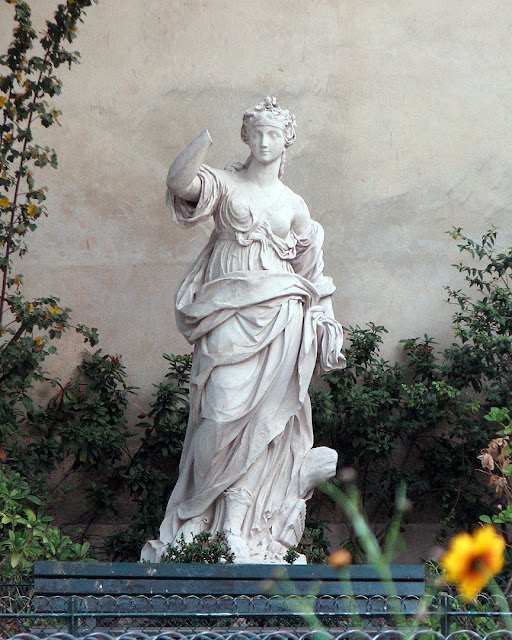Tuesday, May 31, 2016
Chiesa della Natività
Chiesa russa ortodossa della Natività (Russian Orthodox Church of the Nativity)
By Michail Preobrazenskij and Giuseppe Boccini, 1902
Via Leone X
Florence, May 2016
“Early donations from wealthy Russians in Florence, including major contributions by the Demidov princes of San Donato, pushed the project forward. Even so, there remained many funding difficulties to overcome before the church, which is designed in the northern Russian style, could be consecrated upon completion on October 26, 1903. The church in Florence houses many historic relics of the Russian Orthodox Church, including works by both Russian and Italian artists. Beautiful icons of the apostles, patron saints of the church and the passion of Christ cover the interior walls. These are hidden treasures for those lucky enough to enter the church when mass services are not being held. The two-level interior, which houses numerous historic artifacts, is a glimpse into the rich history of Russians who called Florence their home.” (A monument in need, The Florentine)
Monday, May 30, 2016
Hay's Galleria
Hay's Galleria by Twigg Brown Architects
London Bridge City, Southwark
London, September 2015
“The easterly end of the site was developed as London Bridge City of which Hay's Galleria' forms part. The decision was made to retain the dock and to restore its tea and produce warehouses surrounding it to provide office accommodation and shops. The dock gates were permanently closed, the 'impounded' area of the dock was covered with a floor to the sill of the wharf-sides and the entire space was enclosed with a glass roof designed by the young architect Arthur Timothy while he worked with Michael Twigg Brown Architects. This scheme was implemented by Twigg Brown Architects as part of their masterplan for the renewal strategy.” (Hay's Galleria, Wikipedia)
Sunday, May 29, 2016
The Boy Columbus
“Colombo giovinetto” (The Boy Columbus) by Giulio Monteverde, 1870
Castello D'Albertis
Montegalletto, Castelletto
Genoa, April 2016
Saturday, May 28, 2016
Bogenspannerin
“Bogenspannerin” (Archer) by Ferdinand Lepcke, 1897
Kolonnadenhof
Alte Nationalgalerie (Old National Gallery)
Bodestraße
Museumsinsel Berlin (Museum Island)
Berlin, September 2011
Friday, May 27, 2016
Carlo & Oriana
The tugboat “Carlo” and the cruise ship “Oriana”
Canale della Giudecca (Giudecca Canal)
Venice, September 2013
“MV Oriana is a cruise ship and ocean liner of the P&O Cruises fleet. The ship was built by Meyer Werft at their shipyard in Papenburg, Germany. At over 69,000 GT, Oriana is the seventh largest of eight ships currently in service with P&O Cruises. She officially entered service with the company in April 1995 and was named by Queen Elizabeth II. Oriana holds the Golden Cockerel as the fastest ship in the fleet. She is the oldest, and longest-serving, ship in the fleet.” (MV Oriana, Wikipedia)
Thursday, May 26, 2016
La Justice Consulaire
“La Justice Consulaire” by Francisque Duret, 1852
Palais Brongniart or Palais de la Bourse
Place de la Bourse
Quartier Vivienne, 2nd arrondissement
Paris, July 2012
See also: Cirque d'hiver - Saint Michel terrassant le démon
Wednesday, May 25, 2016
Palazzo Doria-Tursi
The colonnaded courtyard of Palazzo Doria-Tursi
Via Garibaldi
Genoa, April 2016
“Since 1848 the seat of Genoa City Hall, this grand building (1565-79), also known as Palazzo Doria-Tursi, is conspicuous by its sheer size: the front is three times the length of the other buildings, an indication of the power wielded by Nicolò Grimaldi (the principal creditor of Philip II of Spain), who commissioned its construction. This imposing edifice, designed by Domenico and Giovanni Ponzello, has a magnificent colonnaded courtyard with double staircase leading to the upper loggia. Taddeo Carlone, who designed the impressive portal, was also involved in the decoration of the facade, which is enhanced by the color contrasts of white marble, pink stone and gray slate.” (The Italian Riviera, Touring Club of Italy)
Tuesday, May 24, 2016
Monday, May 23, 2016
Piazza De Ferrari
The square with its fountain
Piazza De Ferrari
Genoa, April 2016
“Piazza De Ferrari is the main square of Genoa. Situated in the heart of the city between the historical and the modern center, Piazza De Ferrari is renowned for its fountain, which was restored in recent years along with a major restyling of the square. Today next to Piazza De Ferrari are numerous office buildings, headquarters of banks, insurances and other private companies, making of this district the financial and business centre of Genoa, so that Genoeses popularly refer to it as the ‘City’ of Genoa.” (Piazza De Ferrari, Wikipedia)
Sunday, May 22, 2016
Portrait of Dedie
“Portrait of Dedie” by Amedeo Modigliani, 1918
Centre Pompidou
Place Georges-Pompidou
Quartier Saint-Merri, 4th arrondissement
Paris, July 2002
Saturday, May 21, 2016
Friday, May 20, 2016
Tour Cortina
104-meter Tour Cortina (Cortina Tower), 1974
Rue du Disque, Les Olympiades
Quartier de la Gare, 13th arrondissement
Paris, July 2010
“The eight tallest towers are each 104 metres (341 feet) tall and are named after cities that have hosted the Olympic games: Anvers (Antwerp), Athènes (Athens), Cortina, Helsinki, Londres (London), Mexico, Sapporo, and Tokyo. Other residential buildings, which are wider than they are tall, complete the district. The opening in June 2007, of the new Métro station at Les Olympiades, as part of the driverless hi-speed Metro line 14 running every 4 minutes, brought Les Olympiades residents and visitors to the Olympiades complex and its esplanade — shops, restaurants, apartments, and recreational facilities — within 11-14 minutes of Saint-Lazare, Madeleine, and Pyramides on the opposite side of Paris and 2–4 minutes from the new Cour Saint-Émilion entertainment centre and Bibliothèque Nationale François Mitterrand.” (Les Olympiades, Wikipedia)
Thursday, May 19, 2016
Pane e Verdure
“Pane e Salame” (Bread and Salami)
Corrected into “Pane e Verdure” (Bread and Vegetables)
Piazza delle Erbe
Genoa, April 2016
Wednesday, May 18, 2016
The Victoria Fountain
Drinking fountain by H.A. Darbyshire, 1862
Erected by Baroness Angela Burdett-Coutts
Victoria Park, Tower Hamlets
London, September 2015
“This pink marble, granite and stone drinking-fountain, with its distinctive cupola, ornamental slate roof, four clock-faces, Gothic arches, sculpted cherubs and inscriptions, was the gift of the wealthy philanthropist Angela Burdett-Coutts to the people who visited Victoria Park in the East End of London. The architect who designed it for her, H. A. Darbishire, was also the architect for the buildings of the charitable Peabody Trust. It is said to have cost £6000, a fortune in those days. No doubt this Victorian extravaganza (‘For the love of God and Country’) gave pleasure as well as clean drinking water to the poor East Enders enjoying the park, and perhaps also edification: it reminded them, for example, that ‘The earth is the Lord's and all that thereon is.’ It is astonishing to come upon now; but could the money have been better spent? Sadly, it has had to be fenced off, presumably to deter vandals.” (The Victoria or Burdett-Coutts Memorial Drinking-Fountain, The Victorian Web)
Tuesday, May 17, 2016
‘Neptune’
‘Neptune’ (galleon)
Ponte Calvi, Porto Antico (Old Port)
Genoa, April 2016
“The Neptune is a ship replica of a 17th-century Spanish galleon. The ship was built in 1985 for Roman Polanski's film Pirates, where she portrayed the Spanish ship of the same name. An accurate replica above the waterline, but sporting a steel hull and a 400 HP auxiliary engine, the Neptune is currently a tourist attraction in the port of Genoa, where its interior can be visited for a 5 euro entry fee. In 2011, she portrayed the Jolly Roger, the ship of Captain Hook, in the TV miniseries Neverland.” (Neptune, Wikipedia)
Monday, May 16, 2016
July Column
“Le Génie de la Liberté” (The Spirit of Freedom), by Auguste Dumont, 1836
Colonne de Juillet (July Column), place de la Bastille
Quartier de la Roquette, 11th arrondissement
Paris, July 2010
“The July Column (Colonne de Juillet) is a monumental column in Paris commemorating the Revolution of 1830. It stands in the center of the Place de la Bastille and celebrates the Trois Glorieuses — the ‘three glorious’ days of 27–29 July 1830 that saw the fall of King Charles X of France and the commencement of the ‘July Monarchy’ of Louis-Philippe, King of the French. It was built between 1835 and 1840.” (July Column, Wikipedia)
Sunday, May 15, 2016
Caterina Campodonico
Caterina Campodonico, the peanuts pedlar, by Lorenzo Orengo, 1881
Porticato Superiore (Upper Arcade)
Cimitero monumentale di Staglieno (Monumental Cemetery of Staglieno)
Piazzale Giovanni Battista Resasco
Genoa, April 2016
“On the left side, at the base of the inner staircase leading to the Upper Arcade (Porticato Superiore), we find one of the most famous monuments: the tomb of Caterina Campodonico, nicknamed ‘the peanuts pedlar’. As is evident from the representation, but also stated in the epitaph in Genoese dialect, recited in the first person, this is a woman of the people who used the money she earned by selling peanuts and doughnuts to have her own funerary monument built, while she was still alive, by one of the sculptors favoured by the bourgeoisie, Lorenzo Orengo (1881). This monument fits perfectly within the context of the period and represents it, with its realism, in the best possible way: in the same way as the rich bourgeois are portrayed with the symbols of the work that led to their success and social advancement (anchors, caduceus, gears, books ...), also the street vendor has herself portrayed with her goods. Note the care with which Orengo sculpted the typical dress of the woman, with fringes and lace, her hair and her gnarled and old hands, holding the doughnuts and strings of peanuts.” (Monumental Cemetery of Staglieno)
Saturday, May 14, 2016
Viewing Platform
Viewing Platform (made of old shipping containers)
King's Boulevard / Goods Way, King's Cross
London, September 2015
“Though Central Saint Martins moved to their new buildings at Granary Square in 2011 and the new King's Cross concourse opened in Spring 2012, much of the area is still building site. In fact, it is one of the largest areas of urban redevelopment in Europe, as you can observe from a specially-installed viewing platform at the junction of King's Boulevard and Goods Way.” (Climb the King's Cross Viewing Platform, Tired of London, Tired of Life)
Friday, May 13, 2016
Thursday, May 12, 2016
The Fat Black Pussycat
The Fat Black Pussycat (old version)
West 3rd Street, West Village
New York, September 2008
“The back room, hidden behind the curtain is a spectacular lounge. Oriental rugs, Moroccan lanterns and the remnants of the buildings original 1880’s windows (now bricked) set the tone. The music – choice selections from the greatest artists of Africa, the Caribbean, the Middle East, and the entire world – set the backdrop. And, if there’s ever a “best lounge seating” competition, this place will win. Antique couches, a full-on throne, and other plush places to plant yourself fill the large space, forming a variety of cozy conversation pits.” (An Overview, The Fat Black Pussycat)
Wednesday, May 11, 2016
Immacolata
“Immacolata” (Immaculate) by Pierre Puget (attributed), 17th century
Chiesa dei Santi Cosma e Damiano (Church of the Saints Cosma and Damian)
Vico dietro il coro di San Cosimo
Genoa, April 2016
Tuesday, May 10, 2016
Soundbridge 2025
“Soundbridge 2025” (a time capsule to be opened in 2025)
Granary Square, King's Cross
London, September 2015
“On June 29th 2012 there was a ceremony at which the sound gift was publicly broadcast. They vinyl recording was then be placed in a time capsule and buried in a wall at the centre of the King’s Cross development area in Granary Square. The burial place was marked by a large blue plaque and all the names of the contributors cut out of steel and secured to the wall surrounding the plaque. The time capsule will not be re-opened until the building development is completed in 2025. The project was included in the London Festival of Architecture’s King’s Cross Focus weekend, from July 6-8th, 2012.” (Soundbridge 2025)
Monday, May 9, 2016
The “Lanterna”
The 117-meter “Lanterna” (Lighthouse of Genoa)
Rampa della Lanterna
Genoa, April 2016
“It is built on the hill of San Benigno at some little distance from the Sampierdarena neighborhood. The cape on which the Lanterna stands was at one time a peninsula before the nearby coastline was filled in and reshaped. To the west, it marked the entrance to the original port of Genoa, today the Porto Antico. Over time, the hill on the cape assumed the name ‘Capo di Faro’, or ‘Lighthouse Cape’; it is also sometimes referred to as the cape of San Benigno, after the convent that once stood there. Today, the hill is gone save for a small rise upon which the lighthouse stands; the rest of it was removed to provide infill for other areas of the city.” (Lighthouse of Genoa, Wikipedia)
Sunday, May 8, 2016
Saturday, May 7, 2016
Church of San Matteo
Church of San Matteo (St. Matthew)
Piazza San Matteo
Genoa, April 2016
“The church was founded in 1125 by Martino Doria, as the private chapel of his family. In 1278 it was totally renewed in Gothic style. The building was again renovated in the mid-16th century by order of Andrea Doria, who commissioned the work to Giovanni Angelo Montorsoli (changes included the presbytery and the dome). It was further renovated in 1557–1559, under design by Giovanni Battista Castello (nave and aisles) and decoration, realized by Luca Cambiaso among the others.” (San Matteo, Wikipedia)
Friday, May 6, 2016
Thursday, May 5, 2016
Wednesday, May 4, 2016
Médiathèque Jean-Pierre Melville
Médiathèque Jean-Pierre Melville, Bibliothèque Marguerite Durand
Rue Nationale / rue de Tolbiac
Quartier des Olympiades, 13th arrondissement
Paris, July 2005
“Jean-Pierre Grumbach was born in 1917 in Paris, France, the son of Berthe and Jules Grumbach. His family were Alsatian Jews. After the fall of France in 1940 during World War II, Grumbach entered the French Resistance to oppose the German Nazis who occupied the country. He adopted the nom de guerre Melville, after the American author Herman Melville, a favorite of his. Melville fought in Operation Dragoon. When he returned from the war, he applied for a license to become an assistant director but was refused. Without this support, he decided to direct his films by his own means, and continued to use Melville as his stage name. He became an independent film-maker and owned his own studio.” (Jean-Pierre Melville, Wikipedia)
Tuesday, May 3, 2016
Chiesa del Gesù
Chiesa del Gesù e dei Santi Ambrogio e Andrea
(Church of Jesus and Saints Ambrose and Andrew)
Piazza Matteotti
Genoa, April 2016
Monday, May 2, 2016
Sunday, May 1, 2016
Castello d'Albertis
Castello d'Albertis (D'Albertis Castle) by Alfredo D'Andrade, 1892
Montegalletto, Castelletto
Genoa, April 2016
“D'Albertis designed the castle in the styles as and architectural collage with a Gothic revival appearance inspired by palaces in Florence and castles of Aosta Valley. Erected between 1886 and 1892 under the supervision of Gothic Revivalist Alfredo D'Andrade, the castle is located on the site of a 13th-century fortified area, which had been reinforced in the 16th century. Alberto not only based his design on the city's foundation, he incorporated and preserved the foundations of the bastion and one of the turrets. Inaugurated for the celebrations of 400 years of Columbus' discover of America, it was the first villa-castle built in Genoa. From top of the hill of Monte Galletto (or Montegalletto), one of the hills in the district of Castelletto, the castle dominates Genoa with a view of the Ligurian Sea.” (Albertis Castle, Wikipedia)
Subscribe to:
Comments (Atom)































